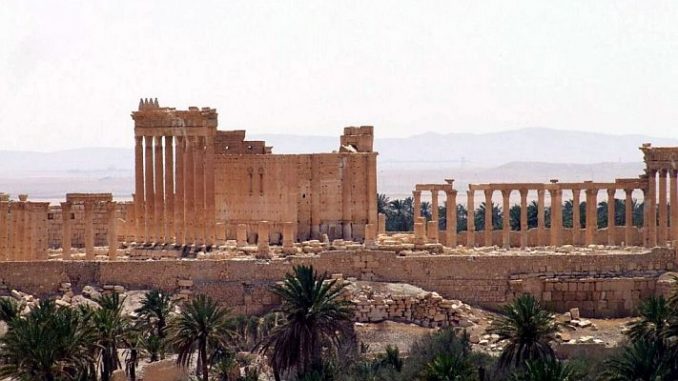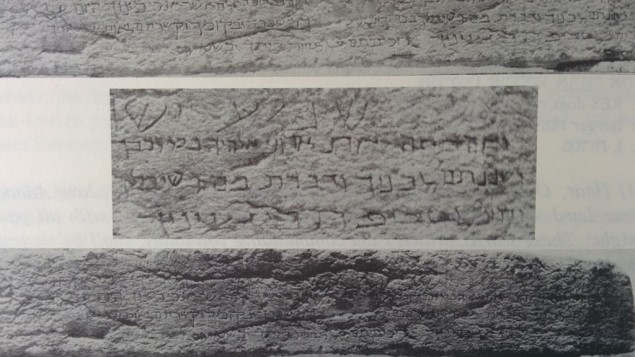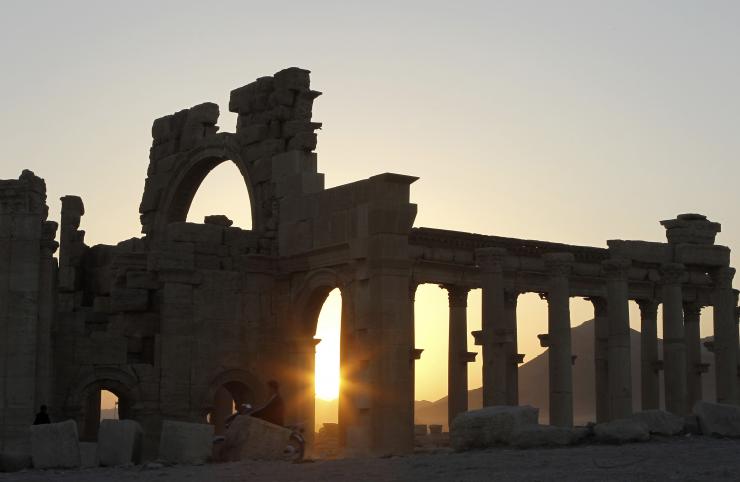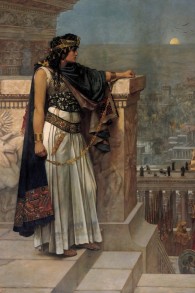
The Ancient Syrian city of Palmyra has been taken over by the ‘Islamic State’. Hundreds have been butchered in public as a demonstration in brutality and intimidation. The UNESCO world heritage site had a thriving Jewish community in its colourful past. Examples of Palmyra’s multi-culture and multi-identity have been documented since the foundation of the ancient city. There is a good chance that some of the the most important Hebrew scriptures from antiquity could be lost forever if the city is destroyed.
All the talk now is whether the ancient city will be raised to the ground or not by the terror group and with it the vestiges of human history. The destruction is something you would normally expect from ISIS, considering their record for destroying archaeological sites in Iraq, such as the ancient Assyrian city of Nimrud, the Roman-era city of Hatra and the destruction in Mosul.

BYPASS THE CENSORS
Sign up to get unfiltered news delivered straight to your inbox.
You can unsubscribe any time. By subscribing you agree to our Terms of Use
Latest Video
Jewish legend contributes the construction of the city, back to the time of King Solomon. The City of Tamar referred to in Kings 1, is believed to be the ‘very great city’ in the Syrian desert known in Hebrew and Aramaic as Tadmor.
However, archaeological evidence is lacking to back up the legend of settled occupation centuries earlier. There is evidence though of the longest Biblical Hebrew inscription from antiquity found at Palmyra. It was carved on a stone doorway and contained the verses of the central Jewish prayer, the Shema. The gem was discovered in 19th and 20th century by western archaeologists.
If Palmyra is destroyed, it will be a crime against all humanity, Gentiles and Jews alike.
The Times Of Israel reports:
Western archaeologists who visited the site in the 19th and 20th century discovered Hebrew verses etched into the doorframe of a house in the ancient city. But whether that inscription is still at the site is unclear.

The last time a European scholar documented it in situ was 1933, when Israeli archaeologist Eleazar Sukenik of Hebrew University photographed it.
“What may have happened to it since is anyone’s guess,” Professor David Noy, co-author of Inscriptiones Judaicae Orientis (Jewish Inscriptions of the Near East), said in an email on Friday.
Palmyra was one of the Roman Empire’s major cities, rising to prominence in the first centuries of the common era as a vassal state and entrepôt connecting West and East. Situated at an oasis in the desert frontier separating the empires of Rome and Parthia, Palmyra grew to an estimated population of 150,000-200,000 at its height in the third century CE. Textiles, perfumes, spices and gems came from India and the Far East, and metals, glass, wine and cash from Rome passed overland, bypassing the longer Red Sea trade route.
Because of its unique location, Palmyrene culture and art exhibited a fusion of Roman and Persian traditions. Traditional Mesopotamian mud bricks comprised the majority of the city’s architecture, Jørgen Christian Meyer, an archaeologist from the University of Bergen explained, but temples to Semitic gods such as Bel, Baalshamin and Al-lat were constructed in Classical style with stout columns hewn of stone.
When the city was abandoned following its destruction in 273 CE and left to the elements, the mud brick disintegrated, leaving behind a petrified forest of stone columns.
During its centuries of prosperity and decline it was home to a thriving Jewish community.
“What we see in Palmyra is a multicultural, and possibly also a multi-identity city,” Meyer, who headed a Norwegian-Syrian archaeological excavation at the site in 2011, just as the civil war started heating up. “Here we’ve got this mixture of Greek, Aramaic, Middle Eastern, Roman culture. This is fantastic.”
“That’s why it’s a unique place from a historical point of view, a cultural point of view,” he said.
Solomon’s Tadmor
That fusion included Jews. Two locally produced terra cotta lamps found next to one of the great pagan temples bear menorahs on either side of a conch, suggesting close integration of Jews and gentiles.

Known in Hebrew and Aramaic as Tadmor, Jewish legend attributed the city’s construction to King Solomon. Josephus Flavius, writing in the first century CE, ascribed its construction to King Solomon, saying that the city of Tamar referred to in Kings I was the “very great city” Josephus’s contemporaries knew in the Syrian Desert.
“Now the reason why this city lay so remote from the parts of Syria that are inhabited is this, that below there is no water to be had, and that it is in that place only that there are springs and pits of water,” the Jewish Roman historian said. “When he had therefore built this city, and encompassed it with very strong walls, he gave it the name of Tadmor, and that is the name it is still called by at this day among the Syrians, but the Greeks name it Palmyra.”
Modern scholars, however, dispute the veracity of Josephus’s claim that it was built by Solomon. Archaeological evidence indicates that the Classical city of Palmyra didn’t predate the first century BCE, and the biblical city of Tamar was likely in today’s Negev Desert.
“The place had certainly existed and had been referred to centuries before. But there is nothing in the archaeological record to show that there was any settled occupation of the site through the Hellenistic period,” wrote Fergus Millar in The Roman Near East. “Suggestions of a phase of urban development in Palmyra before the disturbances of the late Hellenistic period can only be speculation.”
Nonetheless, during Palmyra’s height during the Roman era, the city became home to a substantial Jewish community, as testified in Jewish texts. Two 3rd century CE Jewish tombs in Beit Shearim, outside Haifa, identify individuals as the interred sons of Palmyrenes. A passage in the Mishnah, compiled in the first to third centuries CE, also refers to one Miriam of Palmyra as living in the city during the first century CE.
“It’s clear that there was a serious Jewish community. Jews from [Palmyra] brought them for burial [in Israel] and wrote on the sarcophagus that they were from there.” Daniel Vainstub of Beersheba’s Ben-Gurion University of the Negev said. “We know from the Talmud that some of the locals converted to Judaism.”
But most significantly, etched into the doorway of a house in central Palmyra, northeast of its main colonnaded street, were the four opening lines of the Shema, one of the central Jewish prayers, verses from the book of Deuteronomy. Scholars have debated whether it was an entryway to a synagogue, but now they lean toward it having been a private home.
The Biblical passage differs from the traditional text only inasmuch as it substitutes God’s name Yahweh for adonai — my Lord.
On the sides of the doorway were two other apotropaic inscriptions in Hebrew script believed taken from Deuteronomy as well. It was last photographed in the 1930s, and scholars contacted by the Times of Israel couldn’t ascertain whether it was still at the site, or whether in the intervening decades it was destroyed or sold on the black market.
“They’re part of the limited but clear evidence for Jews at Palmyra,” Tawny Holm, a Jewish Studies professor at Pennsylvania State University, said of the missing finds. They likely dated from before the 6th century CE, possibly from before the city’s destruction in 272-3, but “the inscription could have been added later,” she noted.
The queen of Palmyra
In one of its more thrilling episodes, Palmyra was briefly ruled by Queen Zenobia, who launched a rebellion against Rome. After taking the throne from after her husband’s death in 267 CE, she succeeded in conquering much of the Levant, including Judea, and by 271 had taken Egypt.

Though Christian accounts claimed she was Jewish, there was no contemporary Jewish acknowledgement of such. In fact, Judeans sided with Rome, and Rabbi Johanan bar Nappaha, who lived in the Galilean town of Sepphoris during Zenobia’s rise and fall, is quoted in the Mishnah saying, “Happy will he be who sees the fall of Tadmor.” (He died happy in 279, a few years after the city fell to Rome in 273.)
Evidence of Jewish inhabitation of Palmyra tapers off after the 4th century, Vainstub said, when the re-inhabited city was a shadow of its former glory. Centuries later, after the Muslim conquest, Palmyra began its slow decline into obscurity. At some point a Jewish man, one Tsadik the Cohen son of Eliezer, carved his name into a column of the Temple of Bel, which had years before been converted into a church and then abandoned.
Rabbi Benjamin of Tudela, a 12th century Spanish Jew who chronicled his travels through Europe, Asia and Africa, visited Palmyra during his travels around Syria in the late 1160s or early 1170s. Describing Palmyra, he compares it to the ancient ruins he saw at Baalbek in Lebanon.
“At Tarmod (Tadmor) in the wilderness… there are similar structures of huge stones,” he wrote. Cataloguing Jewish communities he visited, Benjamin of Tudela said Palmyra was hope to about 2,000 Jews — Damascus at the time had 3,000 and Jerusalem he said only had 200.

“They are valiant in war and fight with the Christians and with the Arabs, which latter are under the dominion of Nur-ed-din the king, and they help their neighbors the Ishmaelites,” Benjamin of Tudela wrote.
In 1400, Turkic Muslim conqueror Tamerlane sacked the city and razed it, effectively ending centuries of Jewish inhabitance in Palmyra.
With the site’s conquest to 21st century Islamist warriors, however, archaeologists and historians are fearful for the ruins of the ancient city. The Islamic State may destroy them for the sake of propaganda as they did the antiquities of Hatra and Mosul in Iraq in recent months. UNESCO chief Irina Bokova called for an immediate cessation of hostilities and for the international community “to do everything in its power to protect the affected population and safeguard the unique cultural heritage of Palmyra.”
“No harm has really happened to the ruins of Palmyra, until now,” Meyer, the Norwegian archaeologist who excavated the site, said on the phone on Wednesday. “What will happen now is quite another thing.”
“What I fear now is that ISIS will also use the ruins in Palmyra in their psychological warfare, and that means the destruction of the place,” he said.


